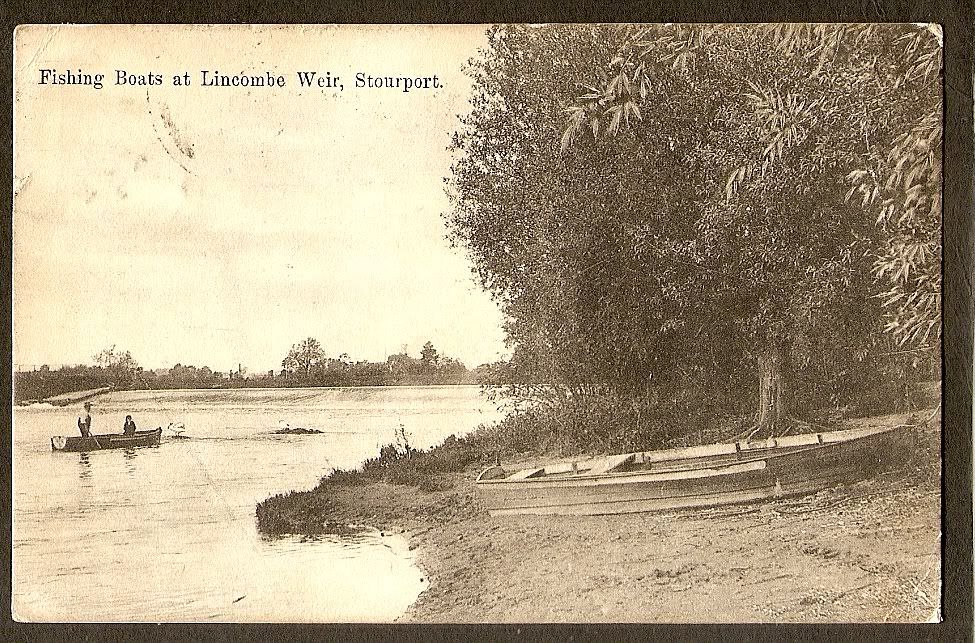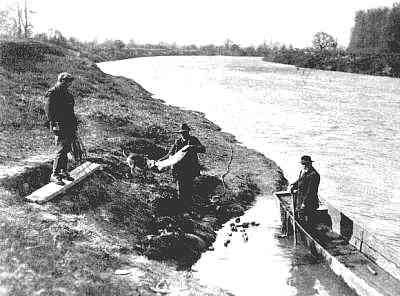Its tributaries are numerous, but those of Montgomery-
shire and above the Vrynwy junction are but of little
account as matters are at present, for few salmon ever reach
there. The Vrynwy, which falls in on the left bank at the
Shropshire border, is a very large tributary, which would
become a fine breeding ground if there were fish to stock it.
Below this junction all the streams falling in on the left
bank are useless for spawning grounds, for salmon do not
ascend there, while on the right bank there is the Dowles
Brook, a favourite spawning place, and joining the main
Stream above Bewdley. Then there is no other tributary of
importance until the Teme falls in below Worcester. In
I860 this pretty river was blocked by a weir at Powick only
a few miles above the junction, and so limited were the
Severn spawning grounds at this time, and so severe was the
netting, that the salmon fisheries were at their lowest ebb.
The weirs, nets and fixed engines
Nets at Lincomb weir Stourport
The navigation weirs, of which there were five con-
structed in 1842, had done much to ruin the river, as none
of them were provided with efficient passes, while above and
below Shrewsbury there were also eel weirs, which were
illegally fished in the spring, solely for the capture of salmon
smolts. The estuary was fished by putts" and "putchers,"
each shore being thickly studded with these engines, which
were easily erected and self-acting, also unlicenced and
worked with a total disregard of all close times ; enormous
was the damage they did, while so long as the exertions of
the upper proprietors protected the spawners and increased the
number of salmon, so pari passu did these fixed engines
multiply, and at this period it was estimated that between
eight and nine thousand putts and putchers " were at work !
By 1863 they had increased to 11,200!!
Then an Act of Parliament provided against any further
increase, titles were closely scrutinized and they were limited
strictly to those that were lawfully exercised at the time of
the passing of the Act of 1861, and all those that could not
produce Charters or show usage from time immemorial were
abolished; until by 1867 the Putts had been reduced to 238,
each working with a 2s, 6d. licence, while the Putchers fell
4,680, with a licence of 20^. for each fifty.
How the putts and putchers worked
These putts and putchers are of great antiquity and, when once set, will
continue to catch by day and by night ; a putcher or " butt,"
as it is called on some parts of the estuary, is a conical-
shaped wicker basket not unlike the old strawberry pottle, it
is about twenty-four inches in diameter at the mouth and
tapers nearly to a point ; they are used chiefly for catching
small fish and shrimps, though they will also catch salmon
and are regarded by the law as engines for taking them :
they are fixed in stages of tiers three, four or five above
each other, and the largest fishery at Goldcliffe near the Usk
mouth, which I think is the property of Eton College, holds
1,200 of them in one rank; their mouths are turned up
stream so as to catch fish dropping back to the sea on the
ebb tide, while close by there is another set of 900 laid with
mouths down stream so as to catch fish coming up with the
flood tide.
Putts are too large to permit of being placed in
tiers above one another, and are set in rows almost touching
each other: they consist of three baskets, the outer one or
'*Knipe" being about six feet in diameter — some are rather
less, some are rather more — the centre basket or putt is of
smaller size, and the lower one called variably the " Diddle "
and " Firewheel " comes nearly to a point, and these larger
engines are used exclusively for catching salmon. Above
Tewkesbury, where the tideway ends, there was a public
right of fishing with nets up to Welshpool, a distance of
eighty-five miles.
Run timings
Clean fish were usually netted on the
opening day, the 2nd of February, though the main harvest was
in May, June and July, while grilse ran in June, July and
August and the kelts have disappeared by the end of April
There are in addition to the five navigation weirs very
many others, close on thirty altogether, including those on
the tributaries, with many small mill weirs in addition. At
Gloucester there are the weirs of Maisemore and Llantony,
then one at Tewkesbury, then Diglis Weir at Worcester
while five miles higher is Bevere Weir and about the same
distance above that is Holt, which is followed by Lincombe
Weir a little below Stourport : then for upwards of fifty
miles the river is free from obstruction until Pool Quay
Weir comes, a little below Welshpool. Then twenty
miles further up there are in close proximity the weirs of
Penarth, Glenhafron, and Milford, and further up at Llanidloes
there is one more. On the Teme, a river of sixty-five
miles, there are five weirs, viz., at Powick, Bramford, Knight-
wick, Martley, and Stanford, with the impassable weir of
Ashford above them.
Upper Teme
The upper proprietors of this river,
with the fate of the upper proprietors of the Severn staring
them in the face, are very antagonistic to the laddering of
any of these weirs. The river as they have it yields splendid
trout and grayling angling ; fish which they can catch and
keep for themselves, with much sport and amusement ; so,
naturally, they say they would rather have this sport than
spoil it by trying to breed salmon for the benefit of greedy
netters below ; and I think they are quite right. In addition
to the evils already mentioned, the Severn suffered from the
drainage pollutions of the large towns on its banks, as well
as from the refuse of the carpet works, tanneries, and dye
yards, and other manufactories, and in fact this fine river
could hardly have fallen into a worse state than that in which
the Act of 1 86 1 found it.
First Conservation activities
Prior to that, with a view of
restoring the fisheries, most of the large towns on the banks
had formed Protection Associations, whose efforts soon begfan
to bear fruit, for in 1862 there was a larger number of salmon
netted than for the thirty-five years previously ; 350 were
caught in the Shrewsbury district, while a fish was actually
killed on the Teme by rod ; the total take was valued at
;^i,ooo worth of fish at wholesale price. This trumpery yield
was at that time a matter of congratulation until someone
pointed out that the Tay in Scotland, which is only about
half the size of the Severn, had that same year brought in
a rental of ;^ 14,000 for its salmon fishings. In 1866, a
Board of Conservators was formed, and putts, putchers, nets,
and rods, were all licenced ; for the latter there were 97
issued at 10^. each, their united take being about 20 salmon!
In 1868 strenuous efforts were made by the Conser-
vators to improve the fish passes in all the weirs. Eighteen
salmon were taken by 70 rod licencees, while the netters
withheld all information.
.
Netsmen at Diglis Weir Worcester in the 1920's
In the twenty years from 1882 to 1901 the Severn yielded 363,825
salmon to the nets, an average of very nearly 18,200 fish
per season. In the same twenty years it yielded but 1,390
fish to the rod, or an average of 68 fish a season ; in arriv-
ing at these figures the rod catch for those seasons for which
no returns were made has been estimated as if it had been
the same as the last recorded season ; in all probability it
would not have been greater or the fact would have been
mentioned, and most likely it was considerably less. Also
it must be borne in mind that from 1891, when the largest
reported take of 200 salmon was made, the rod catches of
that and all the following years are reported as being "about"
such and such a number; this means that they were under
the number named, and so consequently the estimate that
1,390 fish were caught by rods in these twenty years is
considerably in excess of what really were captured.
However, letting the figures stand as they are, it is bad
enough in all conscience, for they show 261 fish to the net
for each one to the rod, which is by far the heaviest per-
centage in favour of the net as against the rod of any river
in the United Kingdom.
A gentleman who has known the Severn for the past
thirty years writes me as follows : — " As to the salmon fishing
on the upper Severn I do not think the river can be called
a salmon angling river at all ; it is true that a certain amount
of fish get up to breed, and occasionally I have known that
a few fish have been taken by the rod at Newtown, but not
of late years. For nearly forty years I have fished for
salmon in the Verniew and its tributary the Banwy, and
about thirty years ago I used to take a few fish each year ;
my largest catch in any one season was nineteen, though in
the past ten years I have only caught five fish, all in October.
Formerly I used to get a few fish in the spring and summer,
but now they are entirely October fish ; in fact there is now
no run of fish until the nets are off in September. At that
time the rod season used to be from February ist to
ist November, but a bye-law has lately been passed which
closes the rod fishing at the 2nd October, which deprives
the anglers of the best chance they had, poor even as it
was."
There can be no doubt that the netting carried on in so
many miles of the river entirely prevents the fish from reach-
ing the upper waters until the close of the rod season. There
is a public right of netting up to Tewkesbury Weir, and
wherever similar public rights have been exercised they have
never failed to ruin the waters above them. It is generally
considered that there is no public right above Tewkesbury
Weir, though there are a few who maintain this extends as
far as Worcester, to which city they allege that the tide
flowed before the weirs were made (the water level still rises at iglis on a big spring tide ed.). Above Worcester private
nets are used in various parts of the river up to Lincombe
Weir near Stourport, which is getting on for fifty miles above
the estuary. Therefore, until this netting can be done away
with, the proprietors of the Severn above Stourport must
abandon all hope of seeing salmon in their waters in any
numbers worthy of mention.



No comments:
Post a Comment
Note: only a member of this blog may post a comment.